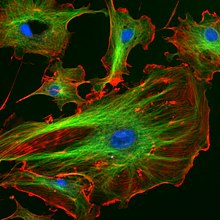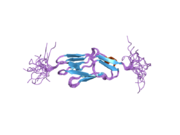Palladin
| PALLD | |||
|---|---|---|---|
Gene ontology | |||
| Molecular function | |||
| Cellular component | |||
| Biological process | |||
| Sources:Amigo / QuickGO | |||
Ensembl | |||||||||
|---|---|---|---|---|---|---|---|---|---|
| UniProt | |||||||||
| RefSeq (mRNA) |
| ||||||||
| RefSeq (protein) |
| ||||||||
| Location (UCSC) | Chr 4: 168.5 – 168.93 Mb | Chr 8: 61.96 – 62.36 Mb | |||||||
| PubMed search | [3] | [4] | |||||||
| View/Edit Human | View/Edit Mouse |
Palladin is a protein that in humans is encoded by the PALLD gene.[5][6][7][8] Palladin is a component of actin-containing microfilaments that control cell shape, adhesion, and contraction.[8]
Discovery
Palladin was characterised independently by two research groups, first in the lab of Carol Otey (in 2000)
Palladin was named after the Italian Renaissance architect Andrea Palladio, reflecting its localization to architectural elements of the cell.[6]
 |
Isoforms
In humans, it appears that seven different isoforms exist, some of which arise through alternative splicing.[11] In mice, three major isoforms of palladin arise from a single gene. These isoforms contain between three and five copies (depending on the isoform) of an Ig-like domain and between one and two copies of a polyproline domain.[6]
Function
Palladin's precise biological role is poorly understood, but it has been shown to play a role in cytoskeletal organization, embryonic development, cell motility, scar formation in the skin, and nerve cell development.[10]
Disease linkage
Recently, it has been demonstrated that palladin
Further, Salaria et al. have shown that palladin is overexpressed in the non-neoplastic stroma of pancreatic cancer, but only rarely in the cancer cells per se,[15] suggesting that palladin's role in this disease may involve changes in the tumor microenvironmment. More research is clearly required before this protein and its role in neoplasia can be fully understood.
Disease-causing mutations have also been identified in the two other members of this gene family.
Interactions
PALLD has been shown to
References
- ^ a b c GRCh38: Ensembl release 89: ENSG00000129116 – Ensembl, May 2017
- ^ a b c GRCm38: Ensembl release 89: ENSMUSG00000058056 – Ensembl, May 2017
- ^ "Human PubMed Reference:". National Center for Biotechnology Information, U.S. National Library of Medicine.
- ^ "Mouse PubMed Reference:". National Center for Biotechnology Information, U.S. National Library of Medicine.
- PMID 10231032.
- ^ PMID 10931874.
- PMID 11230166.
- ^ a b "Entrez Gene: PALLD palladin, cytoskeletal associated protein". nih.gov.
- ^ PMID 11598191.
- ^ )
- PMID 16492705.
- PMID 17194196.
- PMID 17455999.
- S2CID 2445261.
- PMID 17404500.
Further reading
- King CM, Olive CW, Cardona RA (1975). "Activation of carcinogenic arylhydroxamic acids by human tissues". J. Natl. Cancer Inst. 55 (2): 285–7. PMID 1159819.
- Lai CH, Chou CY, Ch'ang LY, et al. (2000). "Identification of Novel Human Genes Evolutionarily Conserved in Caenorhabditis elegans by Comparative Proteomics". Genome Res. 10 (5): 703–13. PMID 10810093.
- Bang ML, Mudry RE, McElhinny AS, et al. (2001). "Myopalladin, a Novel 145-Kilodalton Sarcomeric Protein with Multiple Roles in Z-Disc and I-Band Protein Assemblies". J. Cell Biol. 153 (2): 413–27. PMID 11309420.
- Mykkänen OM, Grönholm M, Rönty M, et al. (2002). "Characterization of Human Palladin, a Microfilament-associated Protein". Mol. Biol. Cell. 12 (10): 3060–73. PMID 11598191.
- Eberle MA, Pfützer R, Pogue-Geile KL, et al. (2002). "A New Susceptibility Locus for Autosomal Dominant Pancreatic Cancer Maps to Chromosome 4q32-34". Am. J. Hum. Genet. 70 (4): 1044–8. PMID 11870593.
- Moriyama K, Bonifacino JS (2003). "Pallidin is a component of a multi-protein complex involved in the biogenesis of lysosome-related organelles". Traffic. 3 (9): 666–77. S2CID 29888859.
- Strausberg RL, Feingold EA, Grouse LH, et al. (2003). "Generation and initial analysis of more than 15,000 full-length human and mouse cDNA sequences". Proc. Natl. Acad. Sci. U.S.A. 99 (26): 16899–903. PMID 12477932.
- Lee SY, Obata Y, Yoshida M, et al. (2003). "Immunomic analysis of human sarcoma". Proc. Natl. Acad. Sci. U.S.A. 100 (5): 2651–6. PMID 12601173.
- Ota T, Suzuki Y, Nishikawa T, et al. (2004). "Complete sequencing and characterization of 21,243 full-length human cDNAs". Nat. Genet. 36 (1): 40–5. PMID 14702039.
- Rönty M, Taivainen A, Moza M, et al. (2004). "Molecular analysis of the interaction between palladin and alpha-actinin". FEBS Lett. 566 (1–3): 30–4. S2CID 86151740.
- Gerhard DS, Wagner L, Feingold EA, et al. (2004). "The Status, Quality, and Expansion of the NIH Full-Length cDNA Project: The Mammalian Gene Collection (MGC)". Genome Res. 14 (10B): 2121–7. PMID 15489334.
- Hillier LW, Graves TA, Fulton RS, et al. (2005). "Generation and annotation of the DNA sequences of human chromosomes 2 and 4". Nature. 434 (7034): 724–31. PMID 15815621.
- Rönty M, Taivainen A, Moza M, et al. (2005). "Involvement of palladin and alpha-actinin in targeting of the Abl/Arg kinase adaptor ArgBP2 to the actin cytoskeleton". Exp. Cell Res. 310 (1): 88–98. PMID 16125169.
- Shiffman D, Ellis SG, Rowland CM, et al. (2005). "Identification of Four Gene Variants Associated with Myocardial Infarction". Am. J. Hum. Genet. 77 (4): 596–605. PMID 16175505.
- Boukhelifa M, Moza M, Johansson T, et al. (2006). "The proline-rich protein palladin is a binding partner for profilin". FEBS J. 273 (1): 26–33. S2CID 21207885.
- Rönty MJ, Leivonen SK, Hinz B, et al. (2007). "Isoform-specific regulation of the actin-organizing protein palladin during TGF-beta1-induced myofibroblast differentiation". J. Invest. Dermatol. 126 (11): 2387–96. PMID 16794588.
- Beausoleil SA, Villén J, Gerber SA, et al. (2006). "A probability-based approach for high-throughput protein phosphorylation analysis and site localization". Nat. Biotechnol. 24 (10): 1285–92. S2CID 14294292.
- Olsen JV, Blagoev B, Gnad F, et al. (2006). "Global, in vivo, and site-specific phosphorylation dynamics in signaling networks". Cell. 127 (3): 635–48. S2CID 7827573.
External links
- palladin+protein,+human at the U.S. National Library of Medicine Medical Subject Headings (MeSH)


